- Manufacturer: Woodhouse for Escofet
- Designer: A. Viaplana / H. Piñon
- Material: reconstructed cast stone
- Dimensions: 85 × 140 × 150
- www.escofet.es
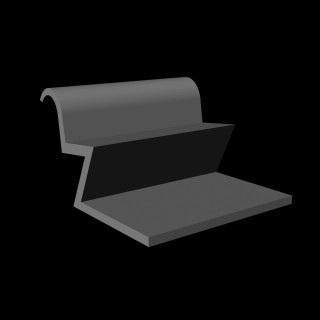
Index
- Manufacturer The company ESCOFET & FORTUNY, a general partnership company, founded by Jaume Escofet [in 1886], is dedicated to the manufacture of pavements. Mosaic
- Cantilever Chair A cantilever chair has no back legs, relying for support on the properties of the material from which it is made. This famous form was designed by Mar
- Street Furniture Street furniture is a collective term for objects and pieces of equipment installed on streets and roads for various purposes, including traffic barri
- Concrete Concrete is a construction material composed of cement (commonly Portland cement) as well as other cementitious materials such as fly ash and slag cem
- Urban Places A public space refers to an area or place that is open and accessible to all citizens, regardless of gender, race, ethnicity, age or socio-economic le
The company ESCOFET & FORTUNY, a general partnership company, founded by Jaume Escofet [in 1886], is dedicated to the manufacture of pavements.
Mosaics
The best example of the Modernist hydraulic mosaics which Escofet realized together with architects such as Lluís Domènech i Montaner or Alexandre de Riquer is the hexagonal Mosaic made by Antoni Gaudí for the interior of la Pedrera. A redisign of the same model would form the pavement of el Paseo de Gracia in Barcelona ninety years later.
www.youtube.com/watch?v=tTihzEuhi1UPavings
By introducing itself into urban spaces through the production of 'panots' to pave the sidewalks of Barcelona the company initiates its close involvement with the public spaces of the city. [In 1950] vibropressed concrete is introduced into Spain by Escofet, giving rise to a series of automatically produced pavings ideal both for inside and outside. All this, together with pavements as significant as that of the Ramblas designed by Adolfo Florensa in 1968, consolidate the presence of the company in the city.
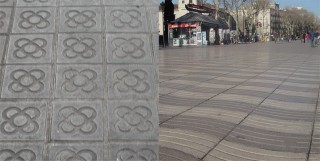
Modular Benches
[In 1979] the production of street furniture is started with the collection of modular benches by Ramón Benedito and Josep Lluscà.
A cantilever chair has no back legs, relying for support on the properties of the material from which it is made. This famous form was designed by Mart Stam in 1926, and remains an important example of 20th century design.Another designer of cantilever chairs was Hungarian designer Marcel Breuer who was experimenting with steel tubing. Alvar Aalto designed several wooden cantilever chairs, made from laminated birch.
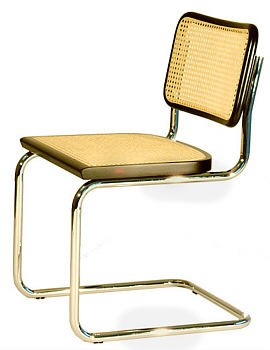
Street furniture is a collective term for objects and pieces of equipment installed on streets and roads for various purposes, including traffic barrier, benches, bollards, post boxes, phone boxes, streetlamps, street lighting, traffic lights, traffic signs, bus stops, grit bins, tram stops, taxi stands, public lavatories, fountains and memorials, and waste receptacles. An important consideration in the design of street furniture is how it affects road safety.
The Anti-clochard Bench
[...] Whenever I visit a town or city, I notice a continuing disappearance of street facilities. I'm not thinking of the street heaters I have never imagined, but of public lavatories, and even of public seats or benches.
Nor is this simply an aspect of the misanthropic British. A bi-lingual book has just appeared in Milan called Panchina/Bench, in which six writers and a dozen photographers and artists consider the use and design of seats in public places. Piero Brunello examines the functions of open-air seats in childhood, youth, adult life, and old age, while the anthropologist Franco La Cecla, who argues that benches are the litmus paper of a country's democracy and tolerance, notes the tendency of big American and European cities to 'extinguish' public benches:
'In Paris, as in America, benches are viewed as suspicious places where clochards, hoboes, immigrants, homeless or ill-intentioned people can find refuge. A new anti-clochard bench, which does not allow stable support, was tested in the Paris Metro. Besides not being able to lie on these benches, people cannot even sit on them, as they were designed as an inclined surface. For the shortest possible amount of time a person can sit on them; it is that person's legs that sustain the entire body weight. In Hong Kong, there are precise rules which prohibit people walking in shopping centres from one great skyscraper to another, from sitting down or even resting for only a few short moments. The public bench seems an infraction of one of the rules of the new autocratic cities of the third millennium. The right to enjoy public spaces is reserved solely for the passer-by who (as the French put it) 'licks' the shop windows. People are only allowed to rest in those places where they must spend money, whether it is a shop, a theatre, or even inside one's own car, which per se fits the logic of forced circulation.'
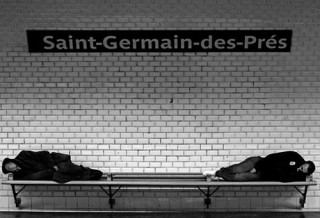
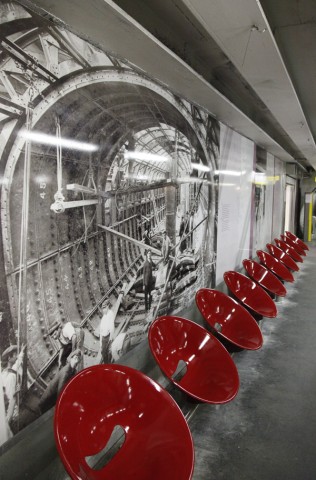
- www.allbusiness.com/professional-scientific/architectural-engineering-related/387590-1.html
- www.chairblog.eu/2009/02/09/new-paris-metro-benches-1/
Anti-graffiti Coating
An anti-graffiti coating is a coating that prevents graffiti paint from sticking to surfaces. Cleaning graffiti off buildings costs billions of dollars annually. Many cities have started anti-graffiti programs but vandalism is still a problem. Companies across the globe are attempting to develop coatings to prevent taggers from vandalizing public and private property. The coatings being developed can be the paint itself, or a clear coat added on top of existing paint or building facades. Depending on the substrate and the severity of graffiti, different coatings give different benefits and disadvantages.
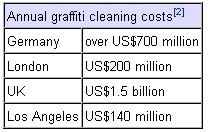
Concrete is a construction material composed of cement (commonly Portland cement) as well as other cementitious materials such as fly ash and slag cement, aggregate (generally a coarse aggregate such as gravel, limestone, or granite, plus a fine aggregate such as sand), water, and chemical admixtures. The word concrete comes from the Latin word 'concretus' (meaning compact or condensed), the past participle of 'concresco', from 'com-' (together) and 'cresco' (to grow).
Concrete solidifies and hardens after mixing with water and placement due to a chemical process known as hydration. The water reacts with the cement, which bonds the other components together, eventually creating a stone-like material. Concrete is used to make pavements, pipe, architectural structures, foundations, motorways/roads, bridges/overpasses, parking structures, brick/block walls and footings for gates, fences and poles.
Concrete is used more than any other man-made material in the world. As of 2006, about 7.5 cubic kilometres of concrete are made each year—more than one cubic metre for every person on Earth. Concrete powers a US $35-billion industry which employs more than two million workers in the United States alone. More than 55,000 miles (89,000 km) of highways in the United States are paved with this material. Reinforced concrete and prestressed concrete are the most widely used modern kinds of concrete functional extensions.
Precast Concrete
Precast concrete is a form of construction, where concrete is cast in a reusable mould or 'form' which is then cured in a controlled environment, transported to the construction site and lifted into place. In contrast, standard concrete is poured into site specific forms and cured on site. Precast stone is distinguished from precast concrete by using a fine aggregate in the mixture so the final product approaches the appearance of naturally occurring rock or stone.
Angelo Mangiarotti
Between 1968 and 1976 Mangiarotti designed a series of exemplary buildings in Veneto, above all factory buildings. He set architectural standards, which were sadly quickly forgotten, otherwise Italy would presumably be less of a concrete jungle today. Nobody expects a roof support structure of prefabricated concrete elements to have a special charisma. But all the factory buildings Mangiarotti designed have a certain elegance. For example, in his construction system 'Briona 72' (1972) a concrete pillar tapering upwards ends in a square ceiling panel and calls to mind a Doric column footing.
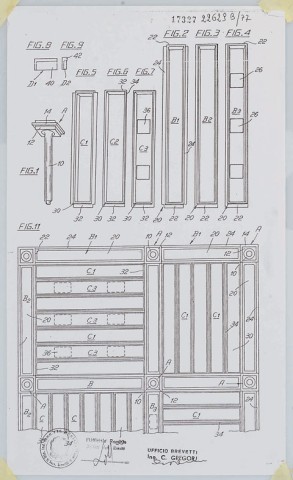
Different Concrete Types and their Future
Textile reinforced concrete, self-cleaning concrete, self-compacting concrete - innovations are definitely not in short supply. The past decades have seen many new advances and improvements. Concrete has, alongside steel, often been hailed as the material of Modernist architecture thanks to its use in the refined building designs of the 1950s as well as in the brutalist structures of the 1960s. It features in minimalist designs just as it does in gigantic dams and bridges with incredible spans. Given that the majority of these projects would have been inconceivable without it, concrete has always been regarded as a miracle material by many, yet it has likewise met with criticism for aesthetic reasons.
The Stylepark Material Edition on 'concrete' features a selection of the most important types of concrete - as regards both material qualities and possible surface finishes. Concrete offers unbounded opportunities for design - and they include a wide range of different surface effects: concrete can be dyed, ground, milled, shaped, printed, painted, polished, washed or mixed with other materials. For example, grinding concrete after it has been cast produces polished surfaces with a terrazzo-like feel. And all you need apply are superhydrophobic or superhydrophilic coatings to the surface to create self-cleaning concretes. Even photo motifs can be transferred onto façade surfaces, in which case the theme becomes a permanent part of the surface of the concrete.
Photo Concrete
The contrasts and colouring which are to be achieved with photo concrete are created by the contrast of finely washed areas to plain areas. The process is based on the different setting times of the concrete. An expressive photo provided by you is enlarged by Hering to the desired format and the photo concrete panel is manufactured in a series of processing steps. In the process, Hering advises you in the selection of the granulation to be used to obtain at the end an image rich in contrast. If the angle of the observer or the incidence of a light source such as the sun changes, the photo concrete panel provides constantly new impressions by virtue of its tiny relief-like recesses.

Graphic Concrete
Graphic Concrete™ technology is based on applying a surface retarder to the surface of a special membrane. The end result is a patterned, smooth or completely exposed surface. The pattern on the concrete surface is a result of the contrast between the fairface and the exposed fine aggregate finish. The cement can be pigmented, which provides the colour for the fairface surface. Aggregates of different colours can also be used, which will be visible on the exposed areas. The depth of the exposure is always about 1 mm.

A public space refers to an area or place that is open and accessible to all citizens, regardless of gender, race, ethnicity, age or socio-economic level. One of the earliest examples of public spaces are commons. For example, no fees or paid tickets are required for entry, nor are the entrants discriminated based on background. Non-government-owned malls are examples of 'private space' with the appearance of being 'public space'.
Town Squares
In urban planning, a city square or urban square is a planned open area in a city, usually or originally rectangular in shape. Some city squares are large enough that they act as a sort of 'national square'.
Squares and monuments with 'inbuilt' seating possibilities
Stairs used as seating elements
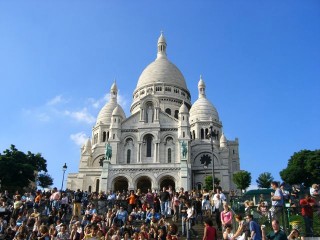
Floor with a slight angle
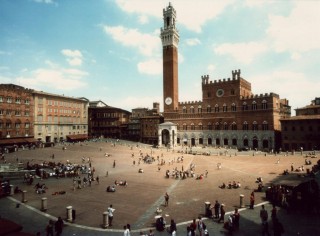
The Monument itslef






























































































